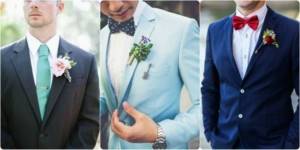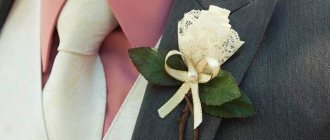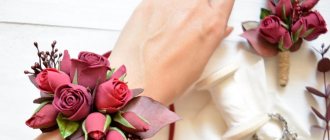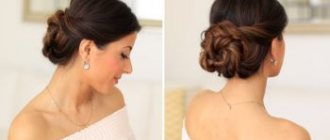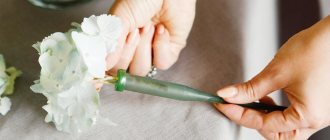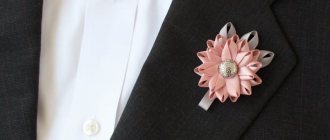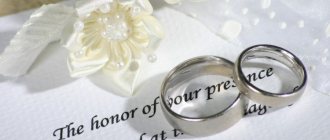Boutonniere for the groom
Content
Now that many wedding traditions have been revised more than once, many couples are faced with the question of whether the groom needs a boutonniere at all. In order to answer this question, we suggest you familiarize yourself a little with the history of this accessory.
According to custom, after the bride ransomed, she took a flower from her bouquet and pinned it on the lapel or pocket of the groom's jacket. This gesture symbolized acceptance of the future husband and an expression of love and fidelity. Therefore, to this day, even when a florist creates the bride’s bouquet and the groom’s boutonniere separately, special attention is paid to ensuring that the style and color of these elements are consistent.
Some also say that such an accessory on the groom’s jacket marks the special solemnity of the event, because men’s wardrobe in everyday life is quite laconic, and it is not customary to decorate it. But on the wedding day everything is different, and therefore the choice of this element should be treated with special attention.
How to attach a boutonniere to a jacket: basic mistakes
Let's look at what not to do when attaching this element:
- Boutonniere in your pocket. This arrangement of this element is unacceptable. This spoils the appearance and is also inconvenient, as it may fall out during the celebration.
- The pin is too weak. A weak fastening element will not withstand the required weight, and the groom will simply lose the flower. Choose a medium-sized pin, and for large bouquets use two .
- Hidden stems. A boutonniere represents more than just flower heads. This is a single element with a bud and stems - a kind of miniature bouquet. Don't try to hide the stems in your pocket or under your lapel.
Now you will definitely not make common mistakes.
When to attach the boutonniere
Immediately after the bride and groom put on their wedding dresses, the required attributes must be added to them: the bouquet is given to the bride, and a boutonniere is attached to the groom’s jacket. From the beginning of the celebration until the very end, they should be in sight: the bride should not let go of the bouquet or leave it somewhere away from her, and the boutonniere should be kept on her jacket.
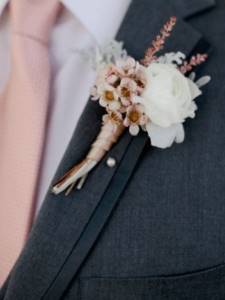
The floral arrangement, which is supposed to be fixed on the lapel, is attached to the left side with a pin. The pin should be positioned with the eye down, and the “tails” of the ensemble should be hidden so that they do not create a sloppy effect.
Decorations made from fresh flowers, meant to be kept in a jacket pocket, often come with a water capsule, allowing them to stay fresh longer. In this case, also on the left side, the accessory is placed in a pocket and sometimes additionally secured with a clip.
A flower in a buttonhole or the history of a boutonniere
The men's accessory, which today is most often used to decorate the groom's clothing, has gone through a difficult and thorny path. The history of the boutonniere contains many different pages - romantic, idle, funny and not so, sometimes even tragic, and undoubtedly deserves attention.
The name of the accessory comes from the French word Boutonnière and means “flower in the buttonhole.” As the name suggests, it is an ornament in the form of one or more flowers that is worn in the buttonhole of a jacket.
Historians are divided on the question of where this accessory was born. Some say that a small bouquet of aromatic herbs first began to be pinned on the groom’s clothes in Ancient Greece. It was attached to the left, in the area of the heart, and it served as a talisman - it protected the groom and his feelings from evil gods who could turn him away from his chosen one. According to others, the history of this men's accessory goes back even further - to the times of the ancient civilization of the Egyptians, who pinned the flower to their clothes as a sign of support for players in sports competitions. One way or another, it was a man’s jewelry, which indicates that the stronger half of humanity is no less romantic. Medieval knights, without taking off, wore such small bouquets of flowers on their chests as a sign of love and devotion to their lady of the heart. The bouquets were made from the beloved's favorite flowers.
But the nature of this accessory was not always peaceful. The boutonniere was also used as a military badge. In England, participants in the civil war, known in history as the War of the White and Scarlet Roses, pinned a brooch in the form of a flower of the appropriate color as a distinctive sign of their side. And the word “boutonniere” itself appeared during wartime. During the French Revolution, this accessory became a symbol of the fearlessness of the revolutionary nobles. Before ascending the scaffold, they inserted a “butonnière” - a red carnation - into their buttonhole. The boutonniere acquired a special, political meaning in the mid-19th century. Representatives of the labor movement wore a red carnation in their buttonholes; it was their obligatory attribute at political demonstrations.
How to choose the right boutonniere
In addition to boutonnieres made from fresh flowers, their production from artificial flowers, as well as berries, leaves and even satin ribbons is widespread. Which boutonniere to choose is up to you. In order to give preference to the most practical option, the following factors should be taken into account:
- Season. An accessory made from fresh flowers, especially without a capsule with water, will not please you for long on a hot summer day, and a composition with artificial elements can replace it. But in winter, the decoration will last longer, so you can safely afford to decorate the groom’s outfit with a live composition.
- Wedding color scheme. If your celebration is made in a certain style, you should not contradict it.
- Bride's dress. The cut, material and shade of the bride's dress play a significant role in the choice of accessory for the groom. A sophisticated composition will suit a strict dress made of fabric of a uniform structure, while a more laconic composition will suit a dress with many decorative elements.
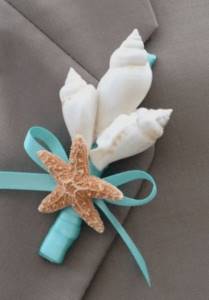
Here are a few rules for choosing a boutonniere that will help you avoid common mistakes:
- You should not choose flowers that are too large or too bright to create a composition. They will draw unnecessary attention to the composition, making it not an addition to the outfit, but an independent element.
- It is not recommended that the accessory be disharmonious with the bride’s bouquet.
- If the composition is made from fresh flowers, but without a capsule with water, in order to avoid early wilting, we advise you to buy special oils that will prolong the life of the flowers. As an alternative, you can prepare several identical boutonnieres in advance so that you can change them during the holiday as needed.
- Flowers with a rich scent and releasing pollen are not recommended to be added to the composition. It will be difficult for the groom to be surrounded by a persistent floral aroma all day. Pollen, in addition to leaving marks on the suit, can be an allergen.
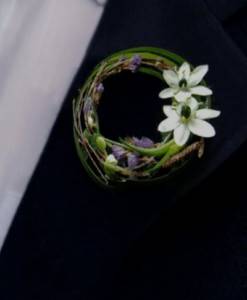
How to position and secure
Having decided on the design of the floral accessory, you need to find out how the boutonniere is attached to the jacket. Traditionally, the composition is attached not only to the groom’s suit, but also to the clothes of witnesses and other guests at the wedding. At the same time, each participant in the wedding celebration has their own rules for wearing this accessory:
- First of all, you need to decide where to attach the boutonniere to the groom. He should place a floral accessory on the left lapel of his jacket. For reliability, the bouquet is fixed with a special pin, which is masked with ribbons, decorative mesh, and beads.
- Bridesmaids should also decorate their outfit with a miniature floral arrangement. They can attach it to their wrist, belt, hair band, purse or even neckline. For bridesmaids, there is a certain rule on which side to hang the boutonniere: unmarried ones fix it on the left, married ones on the right.
- Unmarried groomsmen can place a floral accessory directly on the shirt. As in the case of girls, the location of the bouquet depends on marital status. Unmarried people should attach the boutonniere to the jacket on the left side, and married people - on the right.
When choosing a boutonniere, you need to take into account many details: design, shape of the composition, materials. You can make this accessory yourself or entrust this task to professionals.
How to make your own boutonniere
If it would be better to contact a florist to make a bridal bouquet, then it is quite possible to make a boutonniere yourself. In addition, a hand-made boutonniere for the groom will emphasize a special attitude towards both this small accessory and the entire holiday.
If you decide to create jewelry for the groom yourself, try to work on it in advance, not on the eve of the wedding day. This way you will hone your skills and form an idea of what your composition should look like.
To create a composition of fresh flowers you will need the following materials:
- a fairly large bud that will become central to the composition;
- elements for decoration: small flowers, ornamental plants, berries;
- additional elements: ribbons, beads - to your taste;
- floral wire;
- scissors or nippers;
- tape.
When all these materials are at hand, you can proceed:
- The flower stem must be cut obliquely at the very base of the bud. Before starting to work with a flower, florists recommend placing it in water for three to four hours: this will allow the plant to stay fresh longer. Also, if juice is released from a flower cut, you can dip it in wax or paraffin.
- Place a wire in the center of the bud from above and stretch it so that the end of the wire comes out of the stem.
- To create a boutonniere style, you can and even need to add supporting elements to the main flower. Which one depends only on you. Herbs, leaves, flowers - the choice is almost unlimited. You just need to take into account that additional elements should not be brighter or larger than the central flower, so as not to distract attention from it.
- A composition shaped like a triangle looks good: the top is represented by a central flower, and the cascading frame is located just below the bud.
- The stems of the finished composition are secured, if necessary, with flower glue or tape.
As you can see, the scope for imagination in the process of creating jewelry is enormous. You can make such an accessory in which you will embody all the ideas.
Wearing a boutonniere correctly is an art
Typically, the left lapel of the jacket has a small buttonhole usually used to attach a badge - this is where the boutonniere should be placed. The owners of jackets without a buttonhole adapt and wear the accessory simply, fixing it on the left side of the jacket lapel. The boutonniere must be firmly secured so that it holds securely and you also need to hide its stem. To do this, you just need to insert it into the buttonhole or, if there is none, decorate it with ribbon.
